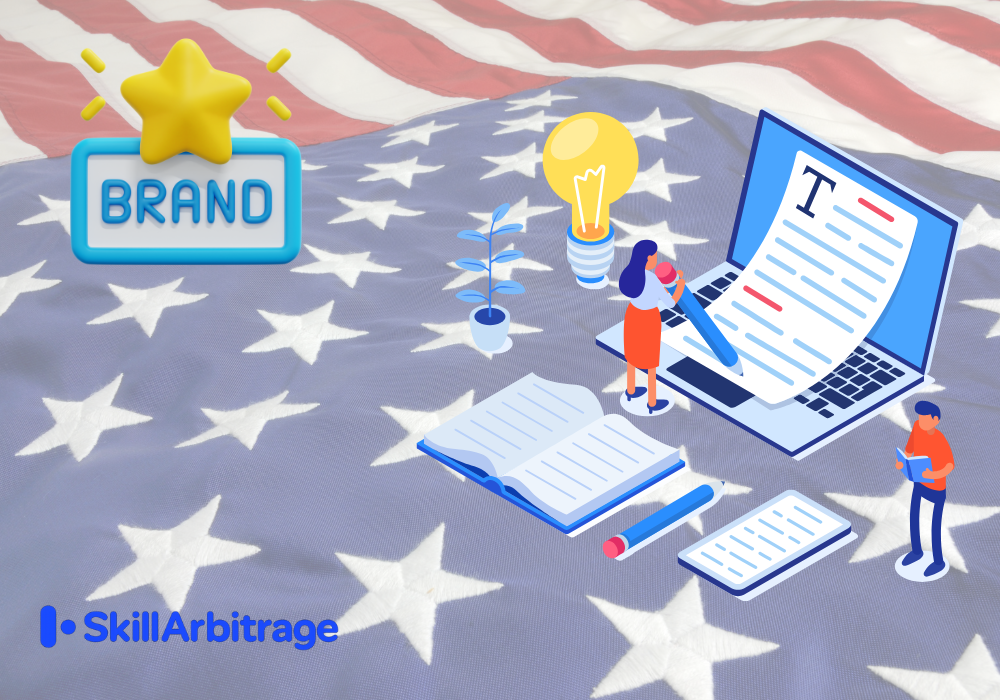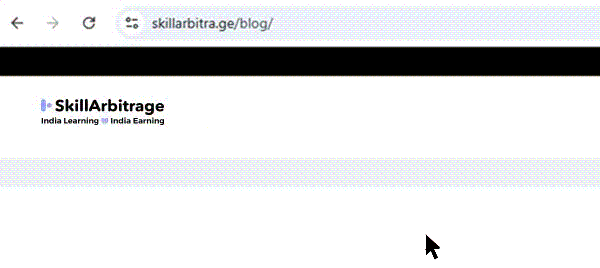This article is for Indian beginners eager to start a copywriting career targeting U.S. lifestyle brand with AI. It covers how to 1) find a profitable niche using free AI tools, 2) create a portfolio that stands out, and 3) craft copy that connects with customers. By the end, you’ll have a clear plan to kickstart your freelance journey with confidence.
Table of Contents
Introduction
Before we get tactical, let’s make one thing clear.
You’re not in the same market as Indian freelancers from five years ago.
You’re in a post-2024 world where brands care more about tone than timezone.
That’s your edge if you can sound native, think fast, and ship sharp content.
And AI is how you close that gap.
This isn’t about “using tools.” It’s about unlocking intel that used to sit behind $10K/month dashboards.
Now? You have it. Free.
The question is, can you wield it better than someone who’s lived in LA their whole life?
Let’s look at someone who did.
- From zero to $500: Riding a viral wellness trend with Grok 3
In January 2025, a 23-year-old freelancer from Mumbai landed her first $500 project for a U.S. mental health app.
She didn’t have a portfolio.
She didn’t have connections.
She didn’t even have an Upwork profile.
What she did have was a Grok 3 prompt, a trend report, and the guts to pitch a client on X with a DM that read:
Your last post on burnout missed what Gen Z is actually dealing with. I used Grok 3 to track 2,100 wellness mentions on X this week. Want to test a post based on what your audience is already venting about?
The post she wrote hit 30 percent more engagement than their average content.
That $500 wasn’t luck. It was a data-informed punch.
Here’s the playbook she used:
Trend mining with Grok 3: She filtered for terms like “mental health Sunday,” “Sunday scaries,” and “fake rest.” Grok surfaced one phrase 187 times: “Feels like I worked all weekend and still failed to recover.” That was her in.
Angle extraction: Most wellness posts were bland advice. She flipped the frame. Her post was a rant disguised as clarity: Your anxiety isn’t random. It’s the bill for your fake productivity.
Punchline format: 100 words. 1 core idea. Ends with a soft CTA: Bookmark this for next Sunday.
The post went live on the brand’s IG and X simultaneously.
Result: saved 110 times, shared 87 times.
The client’s response? We’ve been trying to crack this tone for 6 months.
She cracked it in 3 hours, with Grok 3 as her sidekick.
- How AI levels the playing field
Let’s be blunt.
U.S. lifestyle brands don’t care where you’re from.
They care if you can sound like their audience, feel like their audience, and think like their audience.
AI closes that gap.
You don’t need to live in Brooklyn to write like someone who does.
Grok 3 reads 1,000 posts from Brooklyn yoga instructors, Gen Z coaches, and fashion interns in 10 seconds. Then it tells you what they’re actually sharing, saving, and hate-liking.
That’s the difference.
And unlike ChatGPT, it doesn’t give you lazy, surface-level content.
No “Top 5 Wellness Tips for 2025” drivel. No tone-deaf hashtags.
Grok 3 doesn’t just scrape data. It listens between the lines. It catches rhythm, slang, voice cracks, soft flexes, and subtle jabs, the un-Googleable stuff.
That’s how a freelancer in Mumbai beat a New York agency to a brand voice test.
That’s how a Delhi college student sold “cozy luxury” better than someone with a $6,000/month retainer.
Here’s what AI actually does:
- Automates the research you’d never do manually (reading 2,000+ IG captions and comments? Nope.)
- Finds emotional micro-moments that keyword tools ignore (like “shame when logging off Slack at 7 PM”)
- Stops you from writing like a generic freelancer (Grok 3 is your research intern, not your ghostwriter)
But let’s be honest, AI won’t save bad taste.
You still need judgment. Taste. The gut feel for what sounds right.
But now, you’ve got ammo.
And in a $9 trillion lifestyle market, that’s not an edge.
It’s survival.
The 2025 U.S. lifestyle market: A goldmine for AI-savvy freelancers
The dream isn’t Silicon Valley. It’s Santa Fe.
Not hustle porn. Not VC decks. But slow mornings, skincare fridges, and “I make $40K/month from my laptop” reels.
That’s the lifestyle economy in 2025.
Soft, aspirational, and strangely lucrative.
And someone needs to write it into existence.
That’s where you come in.
- Why lifestyle brands need copywriters
Lifestyle brands don’t sell products.
They sell identity. Taste. Vibe.
And that means they don’t need content, they need copywriters who can translate feeling into phrases.
Take wellness. It’s a $5.8 trillion beast. But no one buys magnesium drops for the science. They buy it because the brand says, “You deserve rest.”
Same with athleisure. $700 billion by 2028, and every leggings brand sounds like it’s pitching therapy.
Tourism? Pushing $9 trillion. But no one clicks “Book Now” because of logistics. They click because of that sentence that makes Bali feel like coming home.
This is where most Indian freelancers miss the plot.
They try to sound polished. Professional. “Optimized.”
But lifestyle brands aren’t looking for polish. They’re looking for presence.
If your copy feels like it came from someone who actually uses the product, wears the hoodie, takes the supplement, and does the 6 AM cold plunge?
You’re in.
And that’s why lifestyle brands are gold.
Big margins. Constant content needs.
And the best part? They’ll pay more for copy that feels like it came from inside their tribe.
So the real question isn’t can you write?
It’s: Can you belong?
And that’s where AI flips the game.
- Keyword research is dead. This is what replaced it
If your research still starts on Google, you’re building yesterday’s funnel.
AI doesn’t guess what people want. It listens to what they’re already screaming about.
Grok 3 doesn’t wait for search intent. It feeds on frustration.
Open Grok 3. Type: “What are people angry about in the wellness space this week?”
You get live X posts. Threads. Rants. Reviews.
It doesn’t just show you what’s hot. It shows you what people are sick of pretending to like.
Here’s what a freelancer in Pune found in March 2025:
People weren’t tired of burnout.
They were tired of being told to breathe through it.
So she pitched a yoga startup with this line:
“Your nervous system doesn’t need ‘peace.’ It needs revenge rest.”
They loved it. Posted it. Hired her.
This is what traditional research misses.
Emotional temperature.
Not “what people are searching for,” but “what they’re sick of hearing.”
That’s what Grok 3 gives you.
Raw sentiment. Unfiltered trends. Copy angles clients didn’t know they needed.
Want to write for eco-luxury brands? Search “greenwashing backlash.”
Want to pitch a tourism client? Find posts complaining about fake ‘offbeat’ itineraries.
AI shows you the tension. You bring the turn.
That’s how copywriters win in the 2025 U.S. lifestyle market:
They don’t write about trends.
They write from inside them.
Find your niche with AI: Step-by-step and top picks
Most freelancers pick a niche based on what sounds cool.
Bad idea.
In 2025, the money isn’t where the hype is.
It’s where the pain is.
And AI is the fastest way to find it.
You’re not selling to everyone. That’s the mistake beginners make, thinking they’ll write for any brand that pays. The real money lies in becoming undeniable to one type of client. So, who’s spending big, growing fast, and desperate for better copy? Use AI to find out, not by chasing trends, but by digging into what’s sparking hate, going viral, or quietly booming. That’s where niches are born. In tension.
- Top 5 niches for 2025
In 2025, the hottest niches are underserved, emotionally charged, and begging for copy that cuts through. These five markets offer high margins and low competition, where your AI-driven copy can make an impact:
Cozy luxury wellness: Sells emotional states like breakup recovery through bathrobes or skincare that feels like insulation from chaos, with brands like Soft Services leading but often with average copy.
Indie fitness apps: Focuses on quirky, tone-driven experiences like trauma-Informed strength coaching or ADHD-friendly running clubs, riding the wave of Peloton fatigue.
Tourism with a POV: Caters to ideological travelers, like women escaping toxic jobs on solo trips or crowd-averse luxury seekers, needing belief-driven copy over generic itineraries.
Quiet tech tools: Offers anti-overwhelm solutions like motion planners or digital fasting apps, where copy should feel like a warm nap, not jargon.
Anti-hustle fintech: Helps users save without the startup grind, pitching lifestyle as freedom, with apps like Calm for your money.
These niches share high emotional stakes and unsophisticated copy. That’s your chance to dominate with AI.
- Step-by-step niche research with AI
Finding your niche in 2025 doesn’t require guesswork. With AI, you can pinpoint what people can’t stop feeling in under three hours, turning raw insights into a market you own. Here’s the process:
- Start with curiosity: Ask Grok 3, “What are people arguing about in wellness, travel, or productivity?” You’ll get threads, rants, and screenshots as your raw material, far richer than generic “best niches” searches.
- Follow the shame trail: Look for what people are embarrassed to admit, like hating team workouts or finding Bali underwhelming. These friction points reveal buying moments your copy can target.
- Sort by emotional texture: Focus on how people express themselves. Venting? Sarcastic? Resigned? Mimic their feelings. Copy isn’t logic. It’s about channeling their emotional pulse.
- Build a swipe vault: Collect “sick-of-it” posts like “I’m tired of…” or “Can we stop pretending….” These show where copy fails by inspiring instead of interrupting, giving you an edge.
- Craft micro-pitches: Write three one-liners using the audience’s words, like “This isn’t skincare. It’s emotional insulation for women who’ve hit their limit.” If a brand thinks, “That’s us,” you’ve won.
This AI-driven approach tunes you into real emotions, not Google guesses, setting you up to own your niche.
Build your portfolio and write killer copy with AI
In 2025, clients won’t linger on your portfolio. They scroll fast, hunting for copy that feels like it belongs in their brand’s world. Forget obsessing over layouts or About Me pages; your portfolio is a pitch in disguise, proving you can nail their tone. AI makes it lethal, turning beginners into contenders. Here’s how to build a portfolio that demands attention and write copy that lands like a punch.
- 5 steps to an AI-powered portfolio
Choose brands you vibe with: Start by picking three U.S. lifestyle brands you’d love to write for, like Lululemon if you’re already mentally rewriting their ads. Select brands whose voice you get instinctively, especially ones whose copy you think you could top. This focus ensures your portfolio feels authentic, not generic.
Reverse-engineer their tone with AI: Use Grok 3 to analyze the brand’s latest Instagram posts, product descriptions, and testimonials, focusing on what gets shared, repeated phrases, and the emotional energy behind them. This isn’t about insights. It’s about mapping their voice so you can mirror it flawlessly. Grok 3 does the heavy lifting, saving you hours of manual scrolling.
Craft bold, platform-native ads: Write two speculative ads per brand, tailored to platforms like Instagram carousels, X threads, or TikTok voiceovers. Take risks to spark reactions, not just approvals, aiming for copy that feels like it came from inside their team. These samples show you can deliver what they need, even without a track record.
Refine with AI feedback: Run your ads through Claude or GPT-4, asking which version feels more emotionally vivid compared to the brand’s last 10 posts. If your copy doesn’t outshine theirs, keep tweaking until it pops. This step ensures your work stands out as sharper and more authentic.
Position your portfolio as a vault: Frame your portfolio as a collection of case studies, not a gallery of past work, with a tagline like, “I study lifestyle brands and write copy that belongs inside them. This is my test vault. You’re next.” Host it on Google Sites (free) to signal confidence and invite clients to see you as their next hire, even without prior gigs.
- How to write emotionally resonant copy
Great copy isn’t about fancy words. It’s about nailing the one thing your audience needs to hear in a tone they trust. AI, especially Grok 3, helps you crack this by eavesdropping on culture, delivering raw insights in seconds. Here’s the process to craft copy that makes brands say, “Finally, someone gets it.”
First, mine emotions with Grok 3 by picking a niche, like travel for exhausted millennials, and asking what they’re done pretending to like. You might find comments like, “We don’t need another retreat with no WiFi. We need one night of sleep without guilt” or “Stop selling Bali like it’s a personality.” These reveal the frustrations your copy can address.
Next, mimic their voice by using Grok 3 to spot tone patterns of slang, sarcasm, or deadpan humor and weaving them into your lines. If Gen Z is venting about skincare with mock-formal rants, your copy should feel like it slipped seamlessly into their group chat. This isn’t writing; it’s channeling their vibe.
Then, ensure every post lands with one idea, one energy, and one sticky punchline, like, “This isn’t a vacation. It’s revenge on burnout.” That single, sharp hook makes your copy memorable and shareable, cutting through the noise of generic posts.
Finally, filter out cringe with ChatGPT by prompting, “Would this post feel off if a Gen Z wellness coach said it?” If it doesn’t pass the vibe check, rework it. AI catches tone-deaf moments, but your taste seals the deal, ensuring copy that feels authentic and electric.
Conclusion: Launch your career with a 5-day AI portfolio challenge
Here’s the part most freelancers skip.
They binge-read. Screenshot headlines. Even save carousels like “5 AI tools to replace your job.”
But when it’s time to ship?
They stall.
So let’s make it simple. Tactical. Time-boxed. Slightly uncomfortable.
A 5-day challenge, not to “learn,” but to launch.
This isn’t prep. This is the career.
No client? Doesn’t matter. No experience? Doesn’t matter. You’re not waiting for permission. You’re building proof that punches through the noise and says, “I can do this. For your brand. Right now.”
We’ve boiled it down. Here’s how to go from zero to a credible, AI-powered portfolio in 5 days:
- Day 1–2: Pick your battleground.
Don’t start with “What’s hot?” Start with: Where are people losing their minds online?
Open Grok 3. Type:
wellness trend backlash
fashion cringe 2025
offbeat travel scams
You’re not looking for inspiration. You’re hunting irritation.
The niche you want is hiding inside emotional chaos. Not “sustainable fashion,” but people mocking $300 ‘ethical’ tees made by interns. Not “fitness for women,” but trauma-informed powerlifting coaches with cult followings.
Found something raw? Good. You’ve got a niche. Now study it like you’re trying to rob it.
- Day 3–4: Make a fake portfolio so good they think it’s real.
Pick 3 brands in your niche. Lurk their socials. Grok their tone.
Then write like you work there. Speculative ads, punchy post rewrites, even a landing page tweak. Use Writesonic to rough-draft if needed, but rewrite with your voice. Not a tool.
Skip the boring portfolio sites. Go to Google Sites. One page. Call it a “vault.” Not a résumé.
Add a headline like
This is not my portfolio. This is proof I get your customer.
Drop your 3 best samples. That’s it.
No bio. No rates. No fluff.
You’re not asking for work. You’re showing them what they’d get if they said yes.
- Day 5: Pitch 5 U.S. brands with this 1-sentence DM
You don’t need a cover letter. Or a “hey hope you’re well” email.
You need tension. Relevance. And guts.
Here’s your starter:
Saw your last post about [topic]. Grok 3 showed me 1,900 people are saying the opposite. Wrote a quick post you could test if you want better saves next week. Want it?
That’s not a pitch. That’s a shortcut to relevance.
Don’t ask for feedback. Don’t ask, “What do you think?” Just write like you already work there.
If one replies? Game on. If none do? Move to the next five. Repeat. Refine. Win.
By next week, you’ll either have 5 new rejections or 1 brand saying, “This is fire, let’s talk.”
That’s how careers start.
Not with a course. Not with waiting.
With a vault. A vibe. And one punchy pitch that lands.
Your move.
FAQs
Q.1: How do I start copywriting with no experience?
Pick a real brand in a hot niche. Use Grok 3 to find what people hate. Write one ad. Polish with ChatGPT. Mock it up in Canva. Host on Google Sites. Done.
Q.2: What are the best niches for Indian freelancers in 2025?
Mental health apps, eco-luxury fashion, slow tourism, digital detox tools, and anti-hustle fintech. High emotion. Low competition.
Q.3: What AI tools should beginners use?
Grok 3 for research. Writesonic for drafts. Canva for visuals. ChatGPT for tone check. All free.







 Allow notifications
Allow notifications
